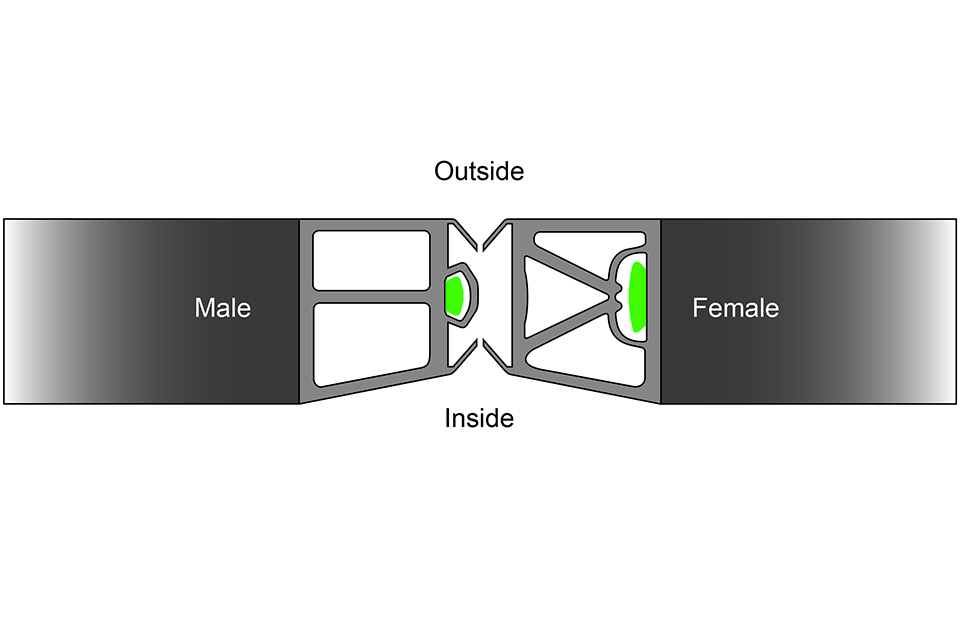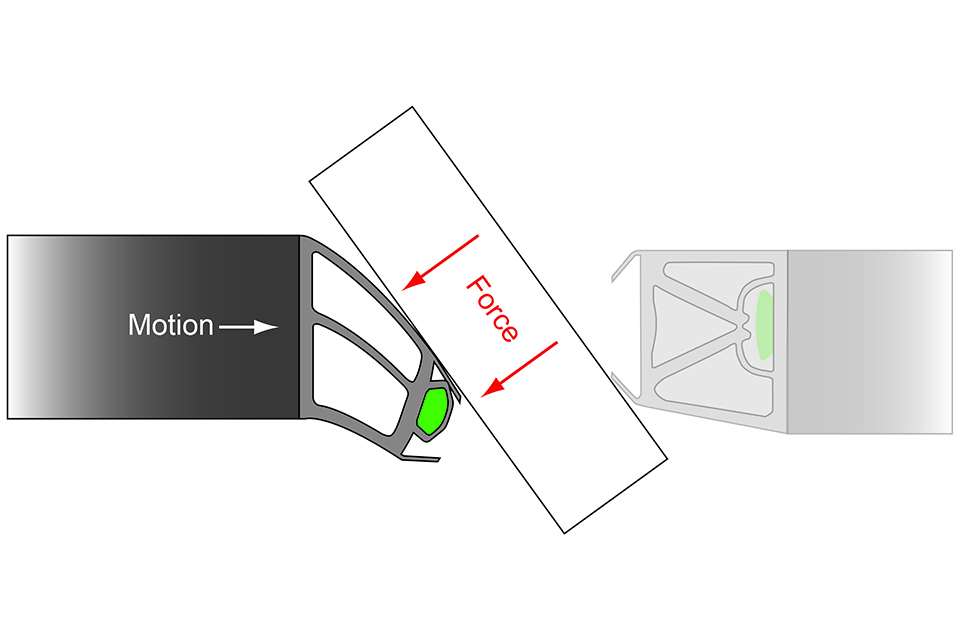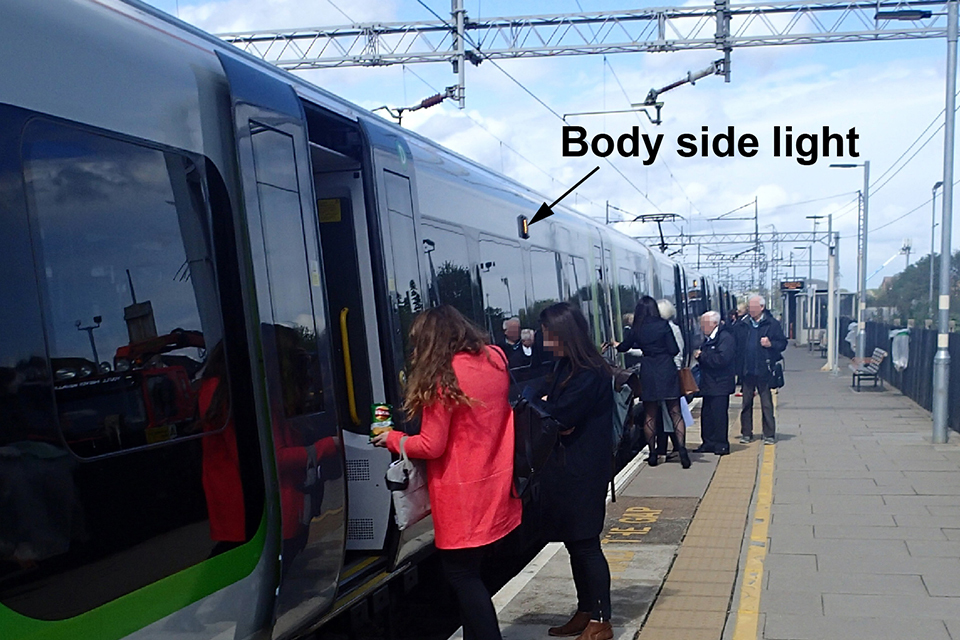Passenger trapped in train doors and dragged at Bushey station, 26 March 2018
Published 29 August 2018
1. Important safety message
This accident demonstrates the importance of staff responsible for the dispatch of trains conducting a thorough final safety check after the passenger doors have closed. They should always remember that in certain circumstances it is possible for the door control system to detect the doors as closed when someone is trapped in them.
2. Summary of the accident
At around 21:24 hrs on 26 March 2018, a passenger was dragged along the platform by a train departing from Bushey station. Her forearm was trapped by an external door of the train and she was forced to walk, and then run, beside it to avoid being pulled off her feet. The train reached a maximum speed of around 9 mph (14 km/h) and had travelled around 27 metres before being brought to a stand by the train’s conductor initiating an emergency brake application. The passenger remained upright, but sustained a minor injury to her forearm.

Platform CCTV images of the rear portion of the train showing the passenger in contact with the train (courtesy of West Midlands Trains)
The train was the 20:59 hrs West Midlands Trains service from Tring to Euston and was formed by two 4-car class 350 Siemens Desiro electric multiple units.
Platform CCTV shows the passenger hurrying onto the platform and reaching the rearmost passenger doors of the train, approximately 75 metres from the conductor, just as the doors were closing. Shortly after departure, the conductor[footnote 1] heard the passenger shouting, sent a ‘stop’ message to the driver and then operated an emergency brake plunger. The passenger was dragged along the platform for around 13 seconds and, once the train had come to a stand, was able to free her forearm from the door. The passenger was given first-aid initially by the conductor and later by staff at London Euston station.
3. Cause of the accident
3.1 Door Design
The class 350 train involved in this accident was fitted with a door system intended to detect the presence of obstructions trapped between closing or closed doors. If an obstruction of a size equal to or greater than defined dimensions is inserted between the door leaves, the system was designed to open the doors and prevent the doors being detected as closed[footnote 2]. Objects are detected by sensitive edges which respond to pressure. These are incorporated in the rubber seals on the edges of the doors. One door includes a ‘male’ edge and the other a ‘female’ edge.
The design requires the female sensitive edge to be switched off shortly before the doors meet so it does not respond to the opposite male edge when they touch (which would cause the door to reopen). The male sensitive edge remains active until the door is closed and locked. The incident doors were tested after the accident by the train maintainer and found to reopen as required when an object of the defined dimensions was inserted between the closing doors.
RAIB has previously found that door systems similar to those involved in the accident at Bushey can be detected as closed and locked with an object, such as a forearm or wrist, trapped between the doors (passenger trapped in train doors and dragged at Newcastle Central station, RAIB Report 19/2014).

Cross-section showing the door edge seals housing the electrical sensing elements (shown in green)
During the Newcastle Central investigation, RAIB tested the passenger doors of a class 185 train, another type of Desiro train fitted with the same design of sensitive door edge as the class 350. The testing found that if a force is applied to the male seal at an angle to the motion of the door, the male door seal can be deflected towards the inside of the coach. The male door edge seal will therefore not press against the female seal. Depending on its size, the object may not compress the female sensitive edge until after this has been switched off by the door detection control circuitry. The result can be a failure to detect a trapped object, such as a wrist or forearm.

Cross–section showing the door seals and the deflected male edge

Adult male wrist, approximately 45 mm by 70 mm, trapped in a class 185 door (of similar design to a class 350 door) detected as closed and locked
Following the accident at Newcastle Central station, RAIB issued urgent safety advice to UK operators of Desiro fleets with electrically operated sensitive door edges. It advised them to consider the need for additional operational and/or technical measures to manage the risk of passengers being trapped and dragged. The following actions, relevant to this urgent safety advice, have been reported by West Midlands Trains and London Midland, the previous holder of this franchise:
- London Midland issued an operational notice to its senior conductors and train dispatchers highlighting the hazard exposed by the Newcastle Central accident.
- London Midland reported that it had been running a campaign since before the urgent safety advice was issued. This involved a mix of posters, station and train announcements, and passenger information system display messages intended to influence passenger behaviour away from trying to board/alight trains when the doors are closing.
- West Midlands Trains reported that passenger doors of its class 350 trains have been fitted with warning signs, stating ‘caution do not enter the train when the doors are closing’.
Investigation of the Newcastle Central accident resulted in RAIB recommending that: ‘Operators of Siemens UK Desiro trains fitted with electrically operated sensitive edges should re-assess the risk of injuries and fatalities due to a trapping and dragging incident in light of failures identified in this report and take appropriate action to reduce the risk’.
The Office of Rail and Road (ORR) latest report to RAIB, dated 16 September 2015, states that two of the three UK operators of these trains have implemented the recommendation. ORR’s report stated that implementation by the third operator, London Midland (now West Midlands Trains), was ‘in progress’.
West Midlands Trains informed RAIB on 23 April 2018 that London Midland had, in addition to the above actions arising from the urgent safety advice, taken the following actions in response to the recommendation:
- made changes to its risk assessment process
- enhanced the consideration of passenger behaviour in its risk assessment
- updated its senior conductor training programme to include learning points from RAIB’s Newcastle Central report
- developed a competence management system for its senior conductors and added platform train interface visual assessments
- issued notices to senior conductors highlighting the need for vigilance during train dispatch
The Newcastle Central report also recommended that: ‘Siemens should redesign the doors, as used on the Class 185 and other similar units, for future vehicles supplied to the UK, to reduce the probability of a passenger being trapped in them but not detected by the door control system. This could be achieved by redesigning the sensitive edges or by other means’.
In response to the recommendation the ORR reported to RAIB that: ‘The design of passenger door, to which this recommendation relates [an air operated system], has now been superseded by electrically operated passenger doors on future vehicles, which provide full control of the opening and closing cycles allowing a different obstacle detection philosophy to be utilised which is much less dependent on, or omits entirely, the sensitive edges’.
3.2 The passenger’s and conductor’s actions
The West Midlands Trains procedure for train dispatch applicable to the accident at Bushey required its staff to use a method known as self-dispatch. The Railway Rule Book[footnote 3] describes this as ‘guard dispatch from an unstaffed platform’. This involves the train’s conductor completing a number of safety checks and then giving the departure signal to the driver. A key task within these safety checks is completing the ‘train safety check’ after the train doors have closed. This is a visual check intended to ensure that the doors are properly closed, that nothing is trapped in them and that nobody is in contact with the train. To achieve the ‘train safety check’ conductors must position themselves on the platform so that they can see the full length of the train’s exterior.
The conductor stated that, after passengers had alighted and boarded the train at Bushey station, he operated the closed door button from a cab at the middle of the train. He then stood on the platform observing the passenger doors close and the train’s body side lights[footnote 4] extinguish.

Body side light - not illuminated when doors are detected as closed and locked
Station CCTV shows the passenger involved in the accident hurrying onto the platform as this was happening. The passenger stated that she was rushing to catch the train and placed her forearm between the closing doors, expecting that they would reopen. RSSB research[footnote 5] recognised that some passengers perceive train doors as similar to lift doors in that they will reopen if they encounter an object.
The conductor stated that he believed the passenger reached the doors after the body side light associated with the vehicle the passenger was attempting to enter had extinguished. However, the CCTV shows that she had arrived just before the doors were fully closed.
The conductor stated he then believed the passenger was close to, but not in contact with, the train and that he instructed the passenger to stand clear of the train. However, the passenger stated that she did not hear any instruction and remained at the doorway with her forearm trapped.
The conductor then closed the door to his cab and the interlock light illuminated when this door was fully closed. The conductor stated he believed the extinguished body side lights and the illuminated interlock light in his cab showed that nothing was trapped in the closed doors. He therefore sent the driver a signal that the train could depart.
Records held by West Midlands Trains show that the conductor had attended safety briefings, in July 2014 and July 2015. The briefing material consisted of a wide range of information including the following:
- ‘Don’t assume that the train-body side lights being extinguished means that persons cannot be trapped in the door’ (2014 briefing)
- ‘Always carry out a thorough train safety check as defined in module SS1 of the rule book and never solely rely on any indication given by the train door interlock circuit’ (2015 briefing)
4. Previous similar occurrences
Other main line accidents with similarities to the accident at Bushey include the following:
- At King’s Cross station, London on 10 October 2011 (RAIB report 09/2012), a passenger was dragged after their fingers were trapped by closing doors and a member of staff on the platform did not fully comply with a requirement to check that nobody was trapped in the train doors.
- At Newcastle Central station, on 5 June 2013 (RAIB report 19/2014), a passenger was dragged along a platform after their wrist was trapped between closing doors. The train’s guard did not carry out the train safety check before dispatching the train.
- At Hayes & Harlington station, on 25 July 2015 (RAIB report 12/2016), a passenger was dragged by a train when the train driver did not identify that her hand was trapped in the closed and locked doors. The investigation found that the door detection system did not detect the passenger’s hand in the closed doors and that the train driver and other train company staff believed that the door interlock system would detect the presence of an object such as a hand.
You can print this safety digest.
-
The conductor was a senior conductor who was also qualified to act as a conductor instructor. ↩
-
Detection of all doors in the closed position completes an interlock circuit which is required before the brakes can be released and traction power can be applied. Completing this circuit illuminates door interlock indicator lights in the driving cab and at doorways where the guard can operate the doors. ↩
-
Rule book GE/RT8000, module SS1, issue 5, September 2017, station duties and train dispatch, section 3.3. ↩
-
Lights on the outside of each coach of the train which are illuminated when the doors of that coach are open or have been released so that passengers can open them using buttons adjacent to the doors. The lights go out when the doors on that coach are detected as closed and locked. ↩
-
RSSB (formerly known as Rail Safety and Standards Board) project T426 ‘Minimisation of accidents at the platform-train interface (2006)’. ↩

